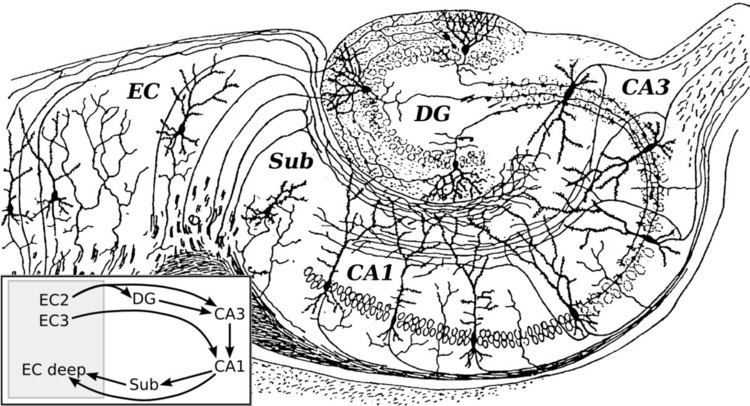NeuroLex ID Hippocampal formation | ||
 | ||
The hippocampal formation is a compound structure in the medial temporal lobe of the brain. There is no consensus concerning which brain regions are encompassed by the term, with some authors defining it as the dentate gyrus, the hippocampus proper and the subiculum; and others including also the presubiculum, parasubiculum, and entorhinal cortex. The hippocampal formation is thought to play a role in memory, spatial navigation and control of attention. The neural layout and pathways within the hippocampal formation are very similar in all mammals.
History and function
During the nineteenth and early twentieth centuries, based largely on the observation that, between species, the size of the olfactory bulb varies with the size of the parahippocampal gyrus, the hippocampal formation was thought to be part of the olfactory system.
In 1937 Papez theorized that a circuit including the hippocampal formation constitutes the neural substrate of emotional behavior, and Klüver and Bucy reported that, in monkeys, surgical removal of the hippocampal formation and the amygdaloid complex has a profound effect on emotional responses. As a consequence of these publications, the idea that the hippocampal formation is entirely dedicated to olfaction began to recede. (Today there is little support for the idea that the hippocampal formation is directly involved in emotion.)
In an influential 1947 review, Alf Brodal pointed out that mammal species thought to have no sense of smell nevertheless have fully intact hippocampal formations, that removal of the hippocampal formation did not affect the ability of dogs to perform tasks dependent on olfaction, and that no fibers were actually known that carry information directly from the olfactory bulb to any part of the hippocampal formation. Though massive direct input from the olfactory bulb to the entorhinal cortex has subsequently been found, the current view is that the hippocampal formation is not an integral part of the olfactory system.
In 1900, the Russian neurologist Vladimir Bekhterev described two patients with a significant memory deficit who, on autopsy, were found to have softening of hippocampal and adjacent cortical tissue; and, in 1957, Scoville and Milner reported memory loss in a series of patients subsequent to their removal of the patients' medial temporal lobes. Thanks to these observations and a great deal of subsequent research, it is now broadly accepted that the hippocampal formation plays a role in some aspects of memory.
EEG evidence from 1938 to the present, stimulation evidence from the 1950s, and modern imaging techniques together suggest a role for some part of the hippocampal formation (in concert with the anterior cingulate cortex) in the control of attention.
In 1971, John O'Keefe and his student Jonathan Dostrovsky discovered place cells, neurons in the rat hippocampus whose activity relates to the animal's location within its environment. Despite skepticism from other investigators, O'Keefe and his co-workers, including Lynn Nadel, continued to investigate this question, in a line of work that eventually led to their very influential 1978 book The Hippocampus as a Cognitive Map. In addition to place cells, three further classes of spatial cell have since been identified in the hippocampal formation: head direction cells, grid cells, and boundary cells. As with the memory theory, there is now almost universal agreement that the hippocampal formation plays an important role in spatial coding, but the details are widely debated.
